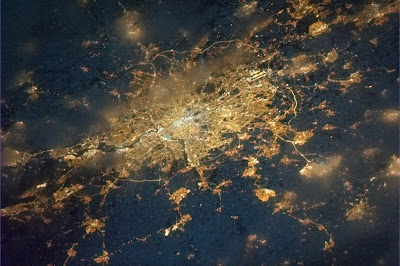 |
| Winter sunset over the Solent from Portsdown Hill - Clive Simpson |
It is hardly surprising to learn that in our modern, consumer-driven culture we are using far more light during the hours of darkness than we actually need.
But what is not generally recognised in our liberal use of illumination is the mounting cost to both the environment and ourselves.
An increasing number of scientific studies are questioning the long-held premise that humans are largely immune to the effects of artificial light at night.
And our own eyes, if only we opened them long enough in a metaphorical sense to see the bigger picture, would surely agree.
Research indicates that artificial nocturnal light - even in quite small doses - disrupts sleep, confuses circadian rhythms and impedes the production of the hormone melatonin.
All of which is bad news if the consequences of excessive exposure to light at night really do include an increased risk for obesity, diabetes and cardiovascular disease.
Technological advances such as LEDs (light-emitting diodes) have certainly improved the potential for better targeted lighting - but they are often brighter and more intrusive than the old lights they are replacing.
And much more of this modern light - whether from TVs, computer screens and electronic gadgets or from outdoor lighting of one form or another - is rich with blue wavelengths and most disruptive to the 24 hour biological process that regulates the body's functions.
In effect, blue light sends subtle messages to our brain that night is over – or in a basic, primal way that morning's blue sky has returned and that the day has begun - quite the opposite signal we need in the middle of the night.
Two years ago the American Medical Association (AMA) called for increased research into the risks and benefits of occupational and environmental exposure to artificial light at night and for the introduction of new lighting technologies at home and at work that minimise circadian disruption.
According to Prof Martin Morgan Taylor, of the School of Law, De Montfort University, Leicester, and a Legal Advisor (Lighting) to the UK Campaign for Dark Skies, the physiological effects caused by lighting may be similar to noise.
In his paper ‘Light Pollution and Nuisance: The Enforcement Guidance for Light as a Statutory Nuisance' he says: "Admittedly, there are comparatively few studies as yet on the problems caused by lighting, but lights can and do wake people up, as does noise.
"Moreover, with noise it appears that the subject does not need to be fully awakened to suffer the same negative effects as someone who has been deprived of sleep altogether."
As a result, people's health could be adversely affected by the floodlighting and what the Chartered Institute of Environmental Health (CIEH) refers to as ‘light briefly turning on and off' during the night.
Prof Morgan Taylor states the research concerning cancer risks does not restrict itself to lighting that wakes the subject but the risk factor is akin to the level of night-time light entering the bedroom.
"The glare from overly bright lighting can also cause further problems, for although the iris may contract to cut down the amount of light entering the eye, the scale of the glare from floodlighting can cause momentary blindness and pain," he says. "This is particularly an issue for the elderly, as the muscles controlling the iris do tend to become less efficient with age."
On a personal level, while we seldom leave our interior lights bare, most of our outdoor lighting remains unshielded – indiscriminately sending light straight into the sky, into our eyes, and into our neighbours' bedrooms.
The relatively simple act of adjusting or shielding outdoor lights by installing or retrofitting lamp fixtures that direct light downward to its intended target represents our best chance to control light pollution.
The generic objection to this - based on the premise that light equals protection and darkness represents danger - is that we need all this light for safety and security.
This common belief goes a long way to explain why many supermarkets, petrol station forecourts and car parks as well as our own driveways and yards are lit more than ten times as brightly as they were just 20 years ago.
In fact, the issue of light at night and safety is rather more complex, with little compelling evidence to support widespread assumptions.
For example, ever-brighter lights can actually diminish security by casting glare that impedes vision and creates shadows where criminals can hide.
The ‘World Atlas of the Artificial Night Sky Brightness', a series of computer-generated maps from satellite data that depict the extent of light pollution across the globe, were created by Italian astronomer Fabio Falchi and illustrate the point nicely.
Today, or to be correct, tonight, we have levels of light hundreds and thousands of times higher than the natural night time level – and light pollution is currently rising by an average of 20 per cent a year.
So this evening, before you flood the yard or your front drive with brilliant light, consider for a moment the opposite side of the day. Would we tolerate, with the same kind of indifference, attempts to modify the daytime by lowering light levels a hundred or a thousand times?
------------------------------------
If you enjoyed this Lighthouse Keeper essay by Clive Simpson looking at the impact of artificial light at night in our modern world please recommend or Tweet the link - Blinded by the night. The title is derived from ‘Blinded by the Light', a song written and originally recorded by Bruce Springsteen and widely known through the 1976 chart-topping version recorded by Manfred Mann's Earth Band.






